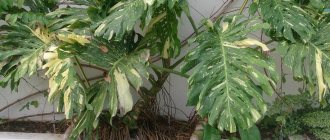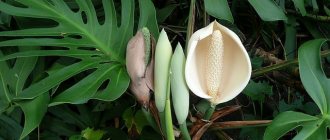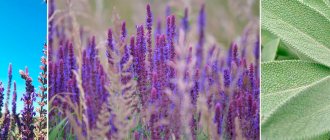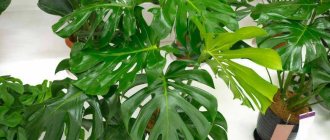Monstera is an evergreen exotic liana of the Araceae family. The epiphyte is native to the humid tropics of South America. The plant has large leaves with cuts or whole. At the top of the shoot there is a growth point.
The adventitious roots are quite long, thick and brittle. The flowers are inconspicuous, but the fruits are edible. The plant genus includes about 50 species and many varieties.
Types of monstera for the home - table
Not all types of plants are suitable for home cultivation; it depends on the region. Most often, two types are grown: oblique and lovely. You can try to keep the vines presented in the table at home:
| Kinds | Description |
| Lovely (Delicacy, Alba, Deliciosa) | Oval leathery carved leaves. The stems are thick and fleshy. |
| Variegata | Variegated leaves with light streaks. Yellow and green colors predominate. |
| Oblique | Slightly dissected oval leaves with short petioles. |
| Adanson (Irregular) | Heavily dissected ovoid thin leaf blades with small holes. |
| Thin | Rarely seen. Pinnately dissected openwork leaves. Slow growth. |
| Borziga | An unpretentious small vine. A variety of Monstera Deliciosa. |
| Doubtful (Dubia) | A small vine with entire leaves. |
Delicatessen
Oblique
Adanson
Thin
Borziga
Dubia
Variegata
Unpretentious nature allowed plants to decorate rooms of houses, offices, and botanical gardens. Thus, the variegated monstera is a symbol of luxury and wealth. It should be remembered that many vines reach large sizes and require a specific place: some species grow up to 3 meters in height.
Pot
When purchasing an exotic beauty and wanting to see how the monstera blooms, you must remember that this crop reaches impressive sizes in a short time. Therefore, she needs a lot of free space and a large pot. It is advisable to choose clay containers with a glazed surface inside and outside. Monstera's powerful roots destroy plastic pots.
Grow young specimens in a regular bucket. But adult monsters will need spacious tubs. Please note that in cramped pots the plant does not have enough nutrients. And as a result, its growth slows down and its decorative qualities deteriorate. And even regular feeding will not correct the situation. Therefore, choose voluminous tubs and pots for flowers.
Caring for monstera by season - table
Liana does not require complex care. She needs a lot of water in the warm season, rest in winter and timely pruning.
At low temperatures in the house, watering should be sparse. Feeding is carried out approximately once every 30 days during growth. If the plant is always in the shade, its crown will become smaller. At very low temperatures, the leaves can turn black, and if you add abundant watering to this, they become lethargic. When the temperature is too high, the leaves curl, this occurs more often in winter.
The table shows plant care by season:
| Season | Lighting | Humidity | Temperature conditions |
| Spring Summer | Slight shadow or diffuse light. To avoid burns, it requires shading on the sunny side. In poor lighting, the leaves become smaller and cuts do not form. | Moderate. In hot weather, spraying is recommended. | From +20 to +25°C without sudden changes. No drafts. |
| Autumn winter | Artificial lighting is required. | Moderate. Regular spraying in a warm room. | Not lower than +12°C. Away from heating devices. |
It is difficult, and sometimes impossible, to achieve monstera flowering at home, since it prefers to bloom in natural conditions, but if you follow all the simple rules for caring for it, this can be achieved.
Temperature
In order for the monstera to bloom, maintain the room temperature from spring to autumn within +22...+25 °C. In winter, the plant tolerates a drop to +16 °C, but it should not be brought to this level. In cooler conditions, the growth and development of the flower slows down, and buds do not appear on it.
To make the monstera feel comfortable, protect it from drafts and cold air coming from the air conditioner. In addition, it is not advisable to place a pot with a plant near radiators and heating appliances.
Planting, replanting, pruning, support
When planting a plant, you need to pay attention to the soil. It should be loose and neutral. There are several mixture options:
- take one part each of humus, peat and sand and add 2 parts of turf;
- mix one part each of bark, leaf soil, peat, moss and ½ part coarse sand;
- Add coconut fiber or perlite to the purchased soil for Saintpaulia.
Young vines should be replanted annually, as they grow very quickly. The pot should be 2-3 cm larger than the old one. It is better if its height and diameter are approximately equal. In a cramped container, the leaves may turn brown and thin, like papyrus.
The soil, drainage material and container must first be sterilized. Drainage should occupy approximately a fifth of the volume.
The plant must be replanted carefully, along with a lump of earth. Dry damaged roots must be trimmed. The vine is placed in the middle of the new container, covered with earth and lightly compacted.
Adult vines are replanted after two years. You will need fairly large flowerpots. It will depend on them how large the vine will be. The new container should be larger than the old one so that the root system feels comfortable.
Since the plant is quite large, it is better to transplant it together. Make the transplant step by step.
Replanting a very large monstera is a difficult task, so over time, only the top old layer of soil is changed with the addition of humus. If you don’t want such problems, you can start a mini plant.
A young monstera definitely needs support, as it curls. In addition, the vine will look more attractive. It is placed in a permanent place and sprayed. For an adult plant, you can make the support yourself. Sticks with coconut fiber are not a very suitable option, as it is difficult for the vine to gain a foothold. To make a support, you can take a piece of plastic tube, longer than the plant, and drill many slots in it. Next, place it in a pot and pour sand inside to the surface of the soil. Moss mixed with peat should be poured on top. The support is wrapped with damp moss, a mesh with cells on top and secured with fishing line. This design also requires regular spraying. Other options are possible.
The plant grows aerial roots, but they cannot be removed. If a vine climbs up a moss tube, the roots will grow into it themselves.
When an adult plant stops growing intensively, you can cut off its top for rejuvenation. The cut should be sprinkled with coal. This procedure promotes the growth of side shoots and crown formation.
Lighting
Do you want to see a blooming monstera at home? Then provide the exotic beauty with optimal lighting. The plant prefers bright, but diffused light, without direct sunlight. The east or west side of the room will do. If you grow monstera near a south window, hang tulle or gauze over the flower during the midday hours.
But in the north, the tropical guest will suffer from lack of light. It, of course, will not die, but here the culture will stop developing and will never bloom. In addition, carved holes are unlikely to appear on its leaves.
Watering, fertilizer
Caring for vines at home is not difficult. The plant does not require frequent watering, although it is moisture-loving. Monstera leaves are covered with a waxy coating and evaporate little moisture. Watering is carried out after the soil has dried from above, preferably with warm water.
Young plants do not need fertilizing, but adults need organic and mineral fertilizers 2 times a month during the warm seasons of the year.
Flower shops have a wide selection of fertilizers. For example, “Agricola 7”, “Nitrophoska”, “Lingogumat” and others. Before use, you should read the instructions.
Description. Benefit and harm to humans
Monstera (Monstera) is a very large plant in the form of an evergreen vine. The study of Monstera is still ongoing and is currently classified as a member of the Aroid family (Araceae).
Monstera leaves are green, perforated and dissected, half a meter long. The juice of the leaves is poisonous and, if it comes into contact with the mucous membrane, causes various reactions: swelling, inflammation, loss of voice, intestinal disorders, dysphagia (swallowing disorder) and numbness.
Indoor monsteras grow up to several meters in length, growing into huge thickets of vines. They crawl along supports using aerial (adventitious) roots. An interesting fact is that if the monstera loses contact with the ground, it will not die, but will live fully on other plants (epiphyte).
Monstera flowers and bears fruit in the form of berries.
Despite its horrific past, the modern house monstera is valued not only for its exotic appearance, but also for its beneficial qualities. During the daytime, monstera leaves release a large amount of oxygen and make the indoor air more humid. They absorb formaldehyde vapors and electromagnetic radiation, ionize the air and evaporate excess moisture.
But at night, the process of photosynthesis completely stops and the plant begins to absorb oxygen in huge volumes. It is for this reason that it is not recommended for children's rooms and bedrooms.
Monstera continues to be ascribed supernatural, but now positive, properties. It is believed that it has a positive effect on the nervous and immune systems, develops intelligence and intuition, and increases performance. This reputation has made the monstera an inhabitant of office premises, classrooms and educational institutions. Psychologists and esotericists love this plant.
Reproduction
Monstera propagates by seeds, cuttings and air layering:
- When propagating by seeds, light and warmth are needed. Seeds are placed in soil or damp moss. They should emerge in a month. It is recommended to leave the planting material overnight in a growth stimulator.
- When propagated by cuttings, stem or lateral shoots are planted in a pot under glass. Cuttings should be short with 1-2 leaves. A cut is made at a right angle on top, and an oblique cut on the bottom. Plantings should be watered and sprayed as the top layer of soil dries. The plant takes root and is placed in a pot.
- A layer with an aerial root and a leaf is planted in a pot.
Monstera - it will not be difficult for you to propagate the plant
Vegetative propagation of monstera is a task that is easy to cope with. All you have to do is use the tip seedling. It must have at least two leaves, as well as a visible aerial root. Spring is the best time to plant a seedling.
Cut off the shoots and place in water. Rooting time depends on the conditions you create for the plant. It’s good if you place the seedling in a place where the temperature is about 25 degrees. Rooting will take about a few weeks.
- Monstera is easy to propagate thanks to apical cuttings that take root in water. Provide the seedling with a temperature of 25 degrees.
Monstera may bloom, although this is rare. The flower is shaped like a flask surrounded by a large white sheath. After flowering, aromatic conical-shaped fruits are formed (ripe fruits are edible, taste like pineapple, but it is better not to eat them, as they can irritate the mucous membranes). Fruit juice is used in Mexico to make drinks, ice cream and sparkling wine.
Pests, diseases, possible problems - table
Diseases and pests rarely affect the vine, but sometimes they cause its death. The plant's leaves may curl, fall off, turn yellow, and dry out.
| Plant diseases | External signs | Fighting methods |
| Chlorosis (carried by aphids and mites) | Yellowing of leaves, appearance of light spots. | Processing with phytofarm. Feeding. Maintaining cleanliness. |
| Root rot | Yellowing and wilting of leaves. | Regulating the watering regime. Removing rotten roots and sprinkling the cuts with charcoal. |
| Spider mite | The appearance of yellow spots and spots on the leaf blades. Falling leaves. Presence of white cobwebs. | Treatment with phytoferm or derris. Regular shower with warm water. |
| Aphid | Curling, deformation and drying of young leaves. | Treatment with insecticide against aphids and preparations with permethrin. |
| Shchitovka | The appearance of hard brown plaques on the back of the leaves, drying of the tips. | Repeated treatment with a damp cloth with soapy water and insecticide. |
Priming
To see Monstera bloom, it is important to plant the tropical beauty in suitable soil. The culture prefers loose, fertile and light soil. A commercial mixture intended for palm trees or violets is suitable. To create your own substrate, mix the following ingredients:
- two parts of turf land;
- one part peat;
- part of perlite or coarse sand;
- one part of leaf soil or humus.
Add some charcoal, sphagnum and bark to this mixture. Before planting a flower, it is necessary to disinfect the soil. To do this, pour the substrate into a basin and pour boiling water over it, mix the mixture thoroughly. When the soil has cooled, sprinkle it on a baking sheet in a 5-centimeter layer and bake in the oven for 30 minutes at 70–90 °C.
Useful properties of the flower
Monstera has the following beneficial properties for humans:
- enriches the air with ions, ozone, oxygen;
- humidifies and cleanses the air of carbon dioxide;
- absorbs harmful substances. Large leaves can effectively absorb formaldehyde contained in plastic and building materials;
- anticipates the weather. If droplets of moisture form on the leaves, it means rain;
- suppresses and prevents the appearance of viruses, fungi and other harmful microorganisms;
- absorbs dust;
- absorbs electromagnetic waves, so it can be placed near a refrigerator, microwave and other appliances;
- decorates the interior. Due to its size, trunk, large dissected and perforated green leaves, the plant will decorate large rooms in the house with its original appearance;
- promotes proper mental activity, strengthens the nervous system, and increases intellectual abilities.
What indoor plants should not be kept at home?
Here is the answer to the question, is it possible to keep a monstera flower at home?
Note! During the flowering period, its beneficial properties increase several times.
In nature, in the humid climate of the tropics, it often blooms and bears fruit, but it is considered impossible to achieve this in the house.
Bloom
Dispelling popular myths
Monstera, an inhabitant of humid subtropics, reaches gigantic sizes in natural conditions. This large vine grows up to 40 meters or more in length, twining around tall trees. Additional long roots grow on its trunks, which can hang all the way to the ground, entwining and growing through everything that gets in their way.
In past centuries, travelers in South America often found monstera thickets in the jungle, next to which lay the skeletons of people and animals, riddled with the roots of these plants. The sight was terrible. In fact, these were the remains of those who accidentally died not far from these thickets, and the roots then grew through everything that came across their path.
But among many peoples there were legends about a dangerous plant that lured travelers and then pierced them with its roots. Since then, monstera (translated as “monster”, “monster”) has retained an ominous mystical reputation. This is the reason why you can’t keep a monstera at home. In fact, this is a very beautiful and rather harmless plant, if you follow some precautions for its maintenance.











